Say Goodbye to Slow Drains: Natural and Cheap Unblocking Methods
By Brian on August 20, 2025

Why Finding the Best Natural Drain Solutions Matters
The best way to unblock a drain doesn’t have to involve harsh chemicals or expensive emergency plumber calls. When you’re standing in ankle-deep shower water or watching your kitchen sink refuse to drain, you need solutions that work fast and won’t damage your pipes.
Quick Answer: Top 3 Methods to Unblock Any Drain
- Boiling Water Flush – Pour slowly in 2-3 stages to dissolve grease buildup
- Baking Soda + Vinegar – Natural chemical reaction breaks up clogs and deodorizes
- Plunger or Drain Snake – Physical removal for stubborn hair and debris clogs
Most drain clogs happen gradually. Grease and oil solidify in kitchen pipes over time, while hair and soap scum build up in bathroom drains. The good news? You probably have everything you need to fix minor clogs sitting in your kitchen cabinets right now.
Natural methods are safer for your pipes, your family, and your wallet. Chemical drain cleaners can actually damage seals and eat away at pipe materials, creating bigger problems down the road. Plus, they’re expensive and often don’t work on tough clogs anyway.
Before you reach for that bottle of harsh drain cleaner or call for emergency service, try these proven DIY methods. They work on most common household clogs and won’t harm your plumbing system.
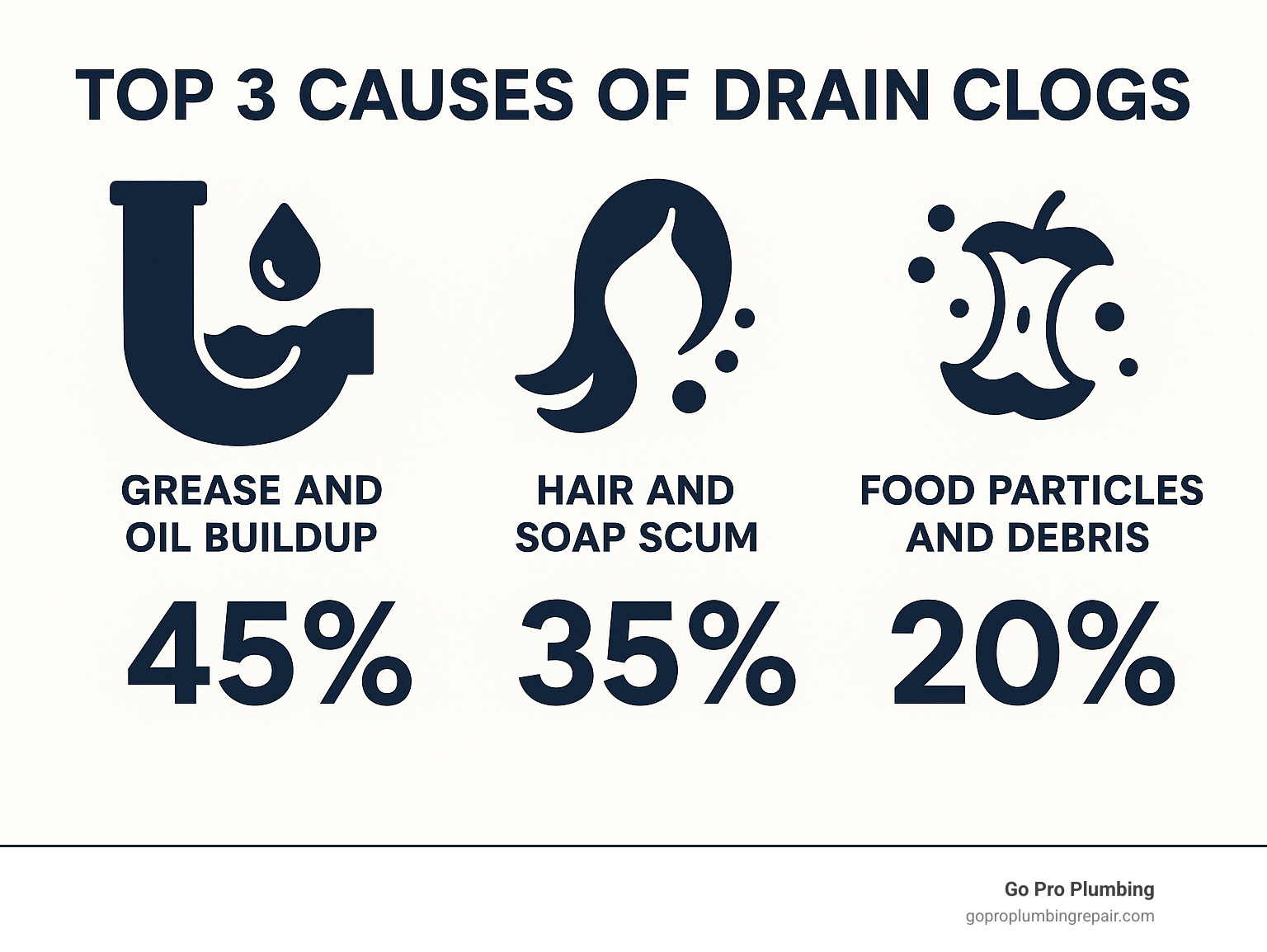
Easy best way to unblock a drain glossary:
First, Identify the Culprit: Common Causes of Clogged Drains
Picture this: you’re washing dishes after a family dinner, and suddenly the water starts backing up in your sink. Sound familiar? Before you can find the best way to unblock a drain, you need to play detective and figure out what’s causing the problem in the first place.
The truth is, most drain clogs don’t happen overnight. They build up slowly over weeks and months, and the culprits are usually different depending on whether you’re dealing with a kitchen or bathroom drain. Let’s break down what’s really going on in those pipes.
Clogs in the Kitchen
Your kitchen sink works hard every single day, and it shows. The biggest troublemaker? Grease and oil buildup – responsible for nearly half of all kitchen drain clogs. Here’s what happens: that bacon grease or olive oil goes down the drain as a liquid when it’s hot, but as it travels through your pipes and cools down, it solidifies and sticks to the pipe walls like glue.
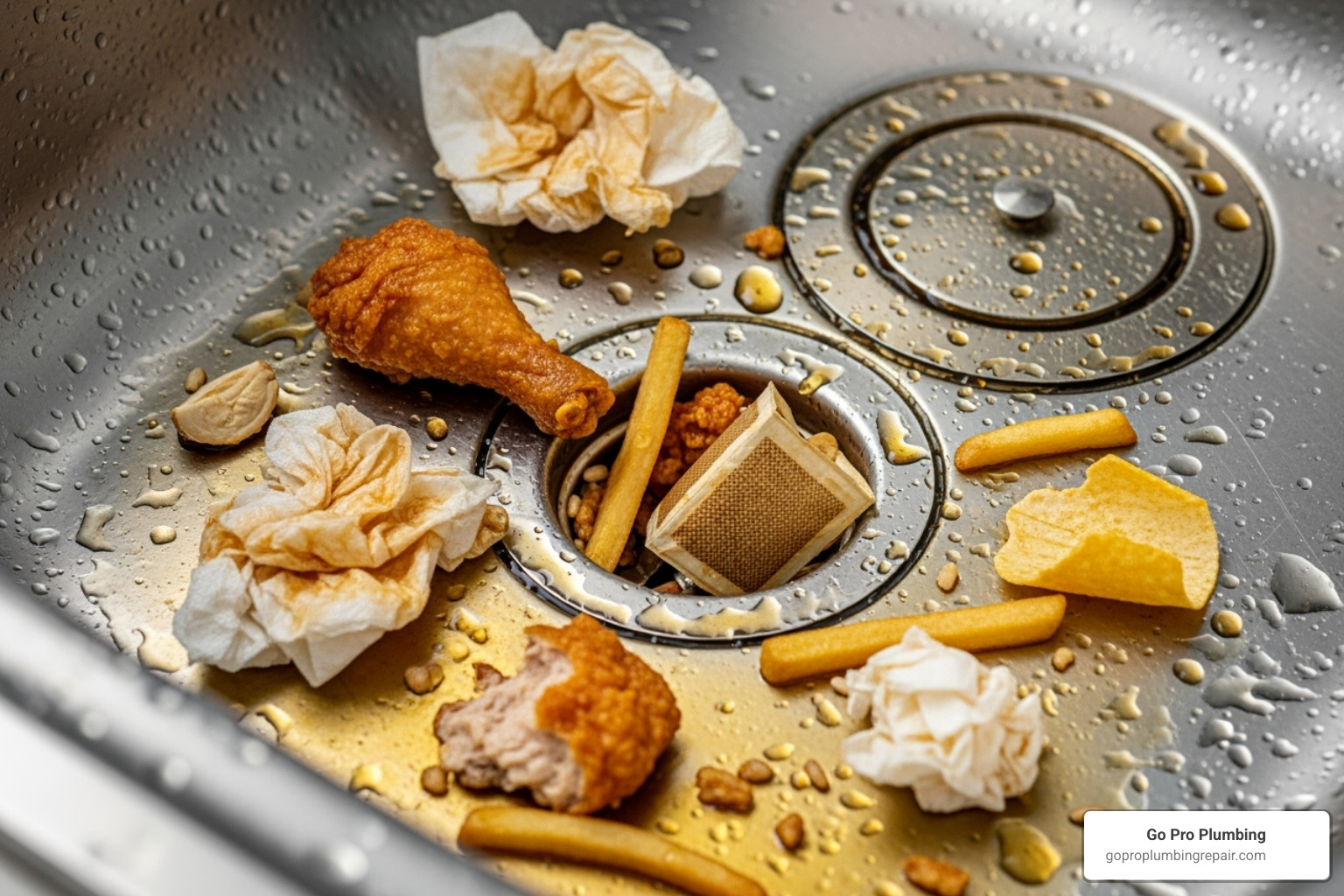
But grease isn’t working alone. Food particles join the party too, accounting for about 20% of drain blockages. We’re talking about those sneaky bits of pasta, rice, coffee grounds, and other small food waste that seem harmless but love to get stuck in the curved sections of your pipes. Even tiny food scraps can team up with grease to create a stubborn clog.
Pro tip: Those innocent-looking coffee grounds are actually one of the worst offenders. They clump together and create a cement-like blockage when mixed with grease and other debris.
If you’re running a restaurant or food service business, these problems multiply fast. Check out our guide on Commercial Kitchen Drain Cleaning for heavy-duty solutions.
Blockages in the Bathroom
Bathroom drains face their own unique challenges, and the main villain here is hair. Every time you wash your hair or shave, some of it inevitably goes down the drain. A few strands might not seem like much, but hair has a sneaky way of tangling up and catching other debris, creating a web-like blockage over time.
The second major culprit is soap scum and residue, which causes about 35% of bathroom clogs. All those sudsy shampoos, body washes, and bar soaps leave behind a sticky film that coats your pipes. Over time, this residue narrows the pipe opening and gives other debris something to stick to.
Don’t forget about the smaller troublemakers either. Toothpaste, shaving cream, and small objects like cotton swabs or dental floss can all contribute to the problem. These items might seem harmless, but they add to the buildup and can turn a minor slow drain into a complete blockage.
Here’s the thing about soap scum: it doesn’t just cause clogs – it can actually lead to pipe corrosion over time, which is a much bigger (and more expensive) problem.
If your shower is giving you trouble, our Unclogging Shower Drain guide has specific solutions. For sink hair clogs, check out our tips on dealing with Hair in Sink Drain.
Understanding what’s causing your clog is the first step toward choosing the right solution. Once you know whether you’re dealing with grease, hair, or food particles, you can pick the most effective method to get your drains flowing freely again.
Easy & Natural DIY Solutions for Minor Clogs
When you’re staring down a stubborn drain, your first instinct might be to grab the strongest chemical cleaner you can find. But hold on! The best way to unblock a drain often involves simple household items you already have sitting in your kitchen cabinets.
These natural, chemical-free alternatives are gentler on your pipes, safer for your family, and much kinder to your wallet. Plus, they’re eco-friendly solutions that won’t harm the environment when they wash down your drain. Think of these as your first-step solutions – they work surprisingly well on most common household blockages.
For more comprehensive guidance on what really works, check out our detailed breakdown of the Best Thing to Unblock Drains.
The Boiling Water Flush
Sometimes the simplest solutions are the most brilliant. If your drain is moving slowly but not completely blocked, boiling water might be all you need to get things flowing again.
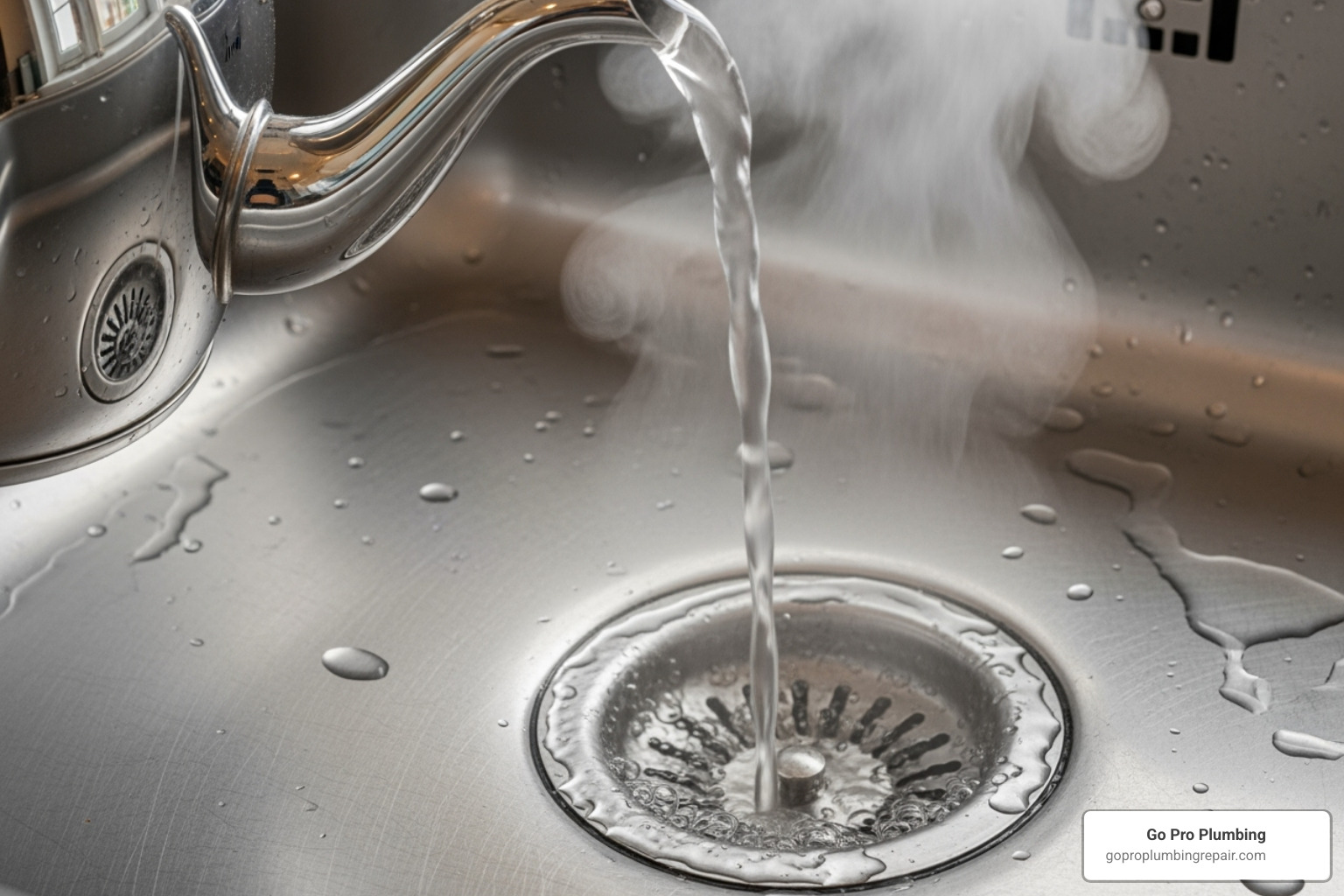
The heat science behind this method is straightforward: boiling water melts grease and dissolves soap buildup that’s coating your pipes. Those fatty substances that seemed so stubborn when cold suddenly become liquid again, allowing them to wash away easily.
Here’s how to do it right: Pour the boiling water slowly down the drain in two or three stages, waiting about 10 seconds between each pour. This gives the heat time to work on breaking down the buildup rather than just rushing past it.
Important warning for PVC pipes: If your home has plastic PVC pipes (common in newer homes), skip the boiling water method. The extreme heat can actually melt or warp plastic pipes, turning a minor clog into a major plumbing disaster. Stick to very hot tap water instead.
The best way to unblock a drain with Baking Soda and Vinegar
This powerhouse combination from your pantry is like a science experiment that actually solves problems. When baking soda meets vinegar, magic happens – or more accurately, chemistry happens.
The reaction creates carbon dioxide bubbles that fizz and foam through your pipes, loosening debris and breaking up clogs naturally. As a bonus, this method also deodorizes your drains, making it perfect if you’re dealing with unpleasant odors. If smelly drains are your main concern, our guide on Smelly Sink Drain has additional targeted solutions.
Here’s your step-by-step approach: Start by removing any standing water from the sink so the mixture can reach the clog directly. Pour about half a cup of baking soda straight down the drain, followed immediately by one cup of white vinegar.
Cover the drain quickly with a plug, rag, or even your hand to trap the fizzing reaction where it’s needed most. You’ll hear the satisfying sound of the mixture working away at your clog. Let it sit for at least 30 minutes – or even overnight for particularly stubborn blockages.
Finish with a hot water flush to wash away all the loosened debris. If you have metal pipes, use boiling water for maximum effectiveness. For PVC pipes, very hot tap water will do the job safely.
This natural method works especially well on clogs caused by grease, soap scum, and light hair buildup. It’s gentle enough to use regularly as part of your drain maintenance routine.
The Best Way to Unblock a Drain Using Simple Tools
When natural remedies aren’t quite cutting it, it’s time to roll up your sleeves and get hands-on. Sometimes the best way to unblock a drain requires a bit of physical intervention to tackle those stubborn clogs that just won’t budge with baking soda and vinegar alone.
The beauty of manual removal is that you’re addressing the problem directly rather than hoping chemicals will dissolve it. Plus, you can actually see what you’re pulling out (though you might wish you hadn’t!). These mechanical solutions are often more effective than chemical alternatives and won’t damage your pipes in the process.
A good Plumbing Snake is one of the best investments any homeowner can make. It’s like having a mini plumber’s tool right in your utility closet.
Using a Plunger: The best way to unblock a drain with pressure
You probably think of plungers as toilet tools, but they’re actually fantastic for sink drains too. The key difference is using the right type – small cup plungers work best for bathroom sinks, while those flange plungers with the extended rubber flap are designed for toilets.
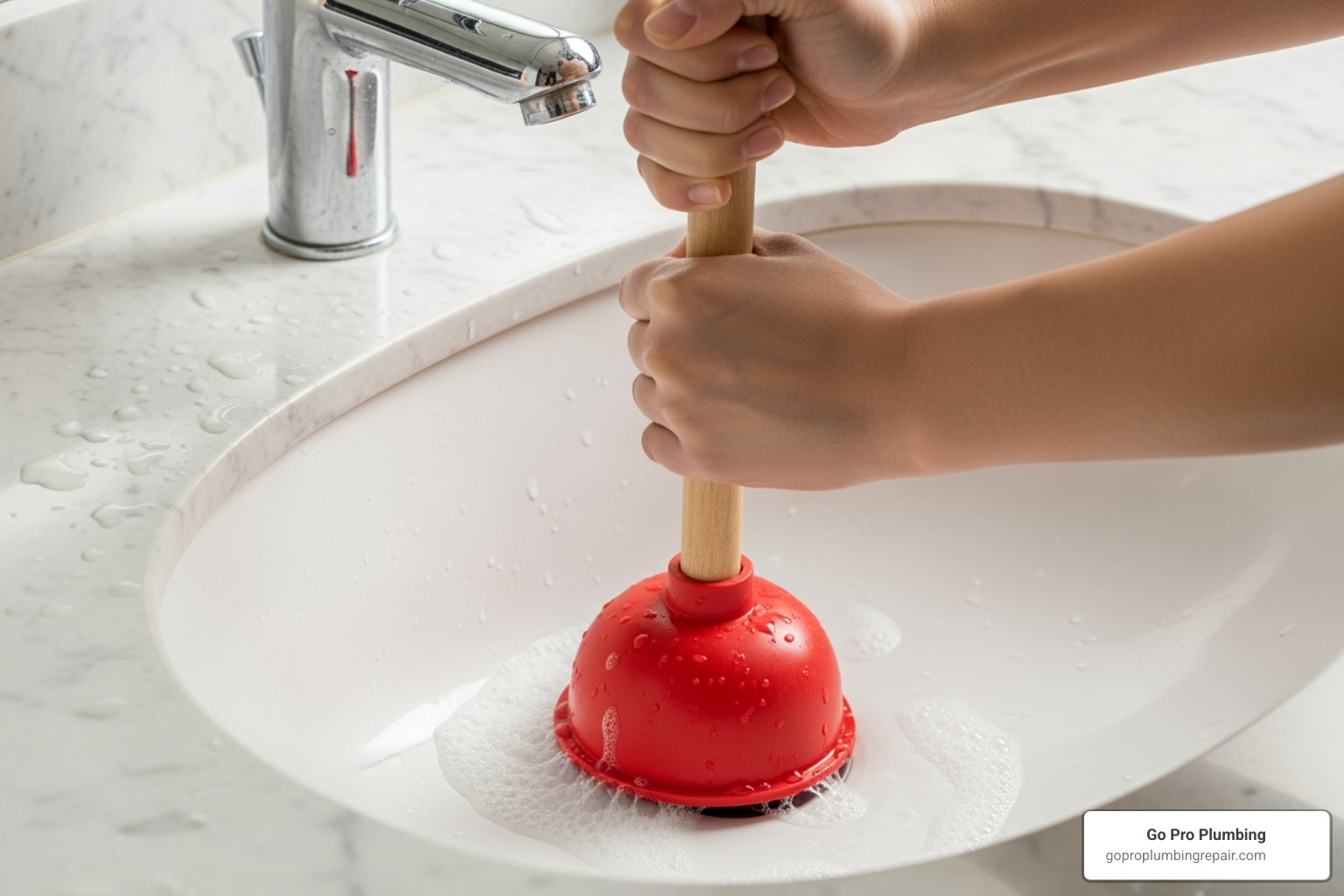
The magic happens when you create a proper seal and use water pressure to push that clog right through. First, make sure there’s enough water in the sink to cover the plunger’s rubber cup – this helps create the suction you need.
Center the plunger over the drain opening and press down firmly. You want a tight seal with no air escaping around the edges. Now comes the workout part – pump vigorously up and down for about 15-20 seconds, focusing on moving that water back and forth in the pipe.
Here’s the satisfying part: on your final pump, pull the plunger up quickly to break the seal. This creates a vacuum effect that often does the trick to dislodge stubborn clogs. If water starts draining freely, you’ve won! If not, give it another round or two.
For our Sacramento area customers dealing with toilet troubles, our team specializes in Sacramento Clogged Toilet Repair when DIY methods aren’t enough.
Using a Drain Snake or Wire Hanger
When plunging doesn’t solve the problem, it’s time to bring out the heavy artillery of DIY drain cleaning: the drain snake. This tool is designed to reach deep into your pipes where clogs like to hide, especially those pesky P-trap blockages that are just out of reach of other methods.
A drain snake can either break up the clog or grab onto it and pull it out – both methods work great depending on what you’re dealing with. Start by feeding the snake into the drain opening, pushing it down until you feel resistance. That’s your clog saying hello.
Once you’ve reached the blockage, turn the handle to rotate the auger head. This spinning action either bores through the clog or entangles it like spaghetti on a fork. Slowly pull the snake back out, and prepare to be amazed (and possibly disgusted) by what comes with it. The amount of hair, soap scum, and mystery gunk that accumulates in drains is truly impressive.
Don’t have a professional drain snake handy? A straightened wire coat hanger makes an excellent substitute for lighter clogs near the surface. Bend one end into a small hook and gently fish around the drain opening. This improvised method works particularly well for hair clogs that haven’t traveled too far down the pipe.
Just remember to be gentle with your makeshift tool – you don’t want to accidentally push the clog deeper into your plumbing system. After you’ve cleared the blockage, run hot water to flush everything through and make sure your drain is flowing freely again.
For more detailed guidance on this essential plumbing tool, check out our comprehensive guide on Drain Plumbing Snake techniques and best practices.
Proactive Prevention: How to Keep Your Drains Clear
The best way to unblock a drain is to never let it get blocked in the first place! Think of it like brushing your teeth – a little daily care prevents big problems later. Once you’ve cleared that stubborn clog, you’ll never want to go through that frustration again.
The truth is, most drain problems develop slowly over weeks or months. That means small changes in your daily routine can make a huge difference. We’ve put together comprehensive guidance on How to Clean Drains to help you stay ahead of clogs before they start. If you’re in our local service area, the Water, Sewer, and Drainage Services | City of Rancho Cordova also provides helpful resources for homeowners.
In the Kitchen
Your kitchen sink works hard every day, dealing with everything from greasy pans to coffee grounds. A few simple habits can keep it flowing smoothly for years to come.
Scraping plates thoroughly is your first line of defense. Even tiny food particles add up over time, especially things like rice and pasta that expand when they get wet. Those “harmless” coffee grounds? They’re actually one of the worst offenders for creating stubborn clogs.
Here’s the golden rule: never pour grease down the drain. We know it’s tempting when you’re cleaning up after cooking, but grease solidifies as it cools and creates a sticky trap for everything else. Instead, pour it into an old jar or can, let it harden, and toss it in the trash.
Installing a simple drain screen is like having a bouncer for your pipes – it catches troublemakers before they can cause problems. These mesh screens cost just a few dollars but can save you hundreds in plumber calls.
If you have a garbage disposal, always run cold water before, during, and for at least 30 seconds after using it. Hot water actually makes grease more likely to stick to your pipes, while cold water helps flush everything away cleanly.
Don’t forget about your dishwasher! Regular maintenance there prevents problems too. Check out our guide on how to Clean Dishwasher Drain to keep your entire kitchen drainage system happy.
In the Bathroom
Bathroom drains face their own unique challenges, mainly from hair and soap buildup. The good news? Prevention is even easier here.
Hair catchers are absolute game-changers. These simple mesh devices sit over your shower and tub drains, trapping hair before it can start the long journey toward a clog. You’ll be amazed (and maybe a little grossed out) by how much hair they collect in just one week.
Your sink’s pop-up stopper is a sneaky collector of hair and toothpaste residue. Clean it regularly by lifting it out and giving it a good scrub. It’s one of those “out of sight, out of mind” spots that can cause big problems if ignored.
Regular hot water flushes work wonders for preventing soap scum buildup. Once a week, pour a pot of hot water down your bathroom drains to dissolve any film that’s starting to form. For an extra boost, follow up with the baking soda and vinegar method monthly.
Finally, your toilet isn’t a trash can. Avoid flushing anything except human waste and toilet paper – yes, even those “flushable” wipes. They don’t break down nearly as fast as advertised and are a leading cause of expensive sewer line problems.
These simple habits take just seconds but can save you hours of frustration and hundreds of dollars in repairs. Your future self will thank you!
When to Skip the DIY and Call a Professional Plumber
While we love empowering you with DIY knowledge, sometimes the best way to unblock a drain is simply picking up the phone and calling the pros. There’s no shame in knowing your limits – in fact, it’s the smart homeowner’s move! At Go Pro Plumbing, we’re here to help in Northern California, including Rancho Cordova and Sacramento, with our outstanding customer service and same-day service.
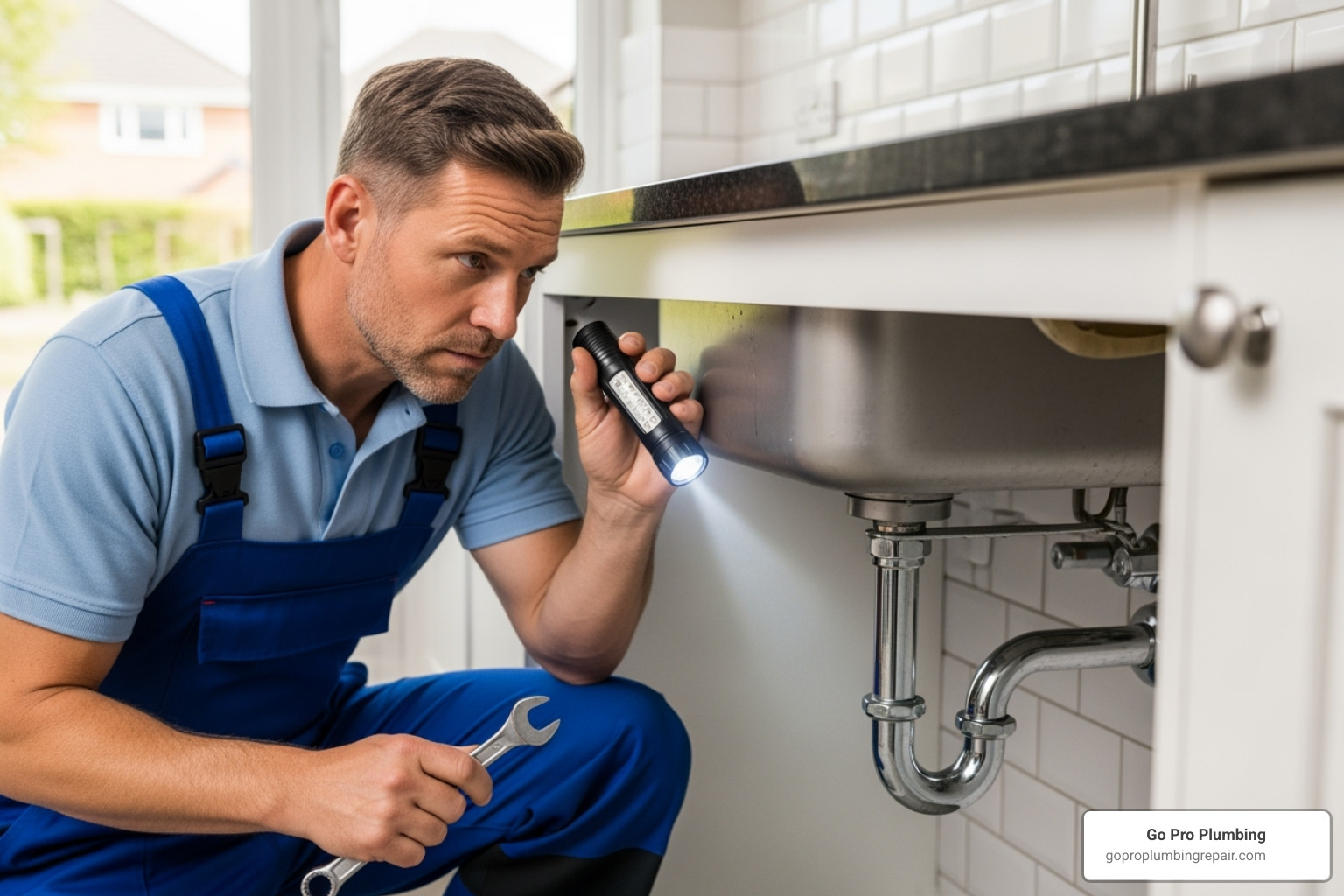
It’s time to call a professional when your DIY efforts have failed. If you’ve tried the boiling water method, the baking soda and vinegar combo, plunging, and even snaking, but that stubborn clog just won’t budge, you’ve done your due diligence. Persistent clogs often indicate deeper issues that require specialized equipment.
Multiple drains backing up simultaneously is a major red flag. When your kitchen sink, bathroom sink, and shower are all draining slowly or backing up at the same time, you’re likely dealing with a main sewer line problem. This isn’t a DIY situation – it’s a job for professional tools and expertise. Learn more about the warning signs of a Sewer Line Blockage.
Foul odors that won’t go away signal serious trouble brewing in your pipes. While minor drain smells can often be cleared with natural cleaning methods, persistent sewage odors indicate blockages or breaks in your sewer system that need immediate professional attention.
Water backing up into other fixtures is perhaps the most alarming sign. If flushing your toilet causes water to bubble up in your shower, or running your washing machine floods your basement floor drain, you’ve got a main line issue that requires emergency service.
The Dangers of Chemical Drain Cleaners
Here’s where we need to have a serious chat about those tempting bottles of chemical drain cleaners lining the store shelves. We strongly discourage using these products, and here’s why your pipes (and your family) will thank you for avoiding them.
Chemical drain cleaners are genuinely dangerous. The active ingredients like sodium hydroxide (lye) can cause severe chemical burns to your skin and eyes. The fumes alone can irritate your respiratory system. Professional plumbers actually dread working on drains that have been treated with these chemicals because of the safety hazards they create.
They’re notorious pipe destroyers. These chemicals work by generating intense heat to dissolve clogs, but that same heat can warp PVC pipes and corrode metal ones. Over time, they eat away at the seals that prevent leaks, turning a simple clog into a major plumbing disaster. The cure becomes worse than the disease.
Most frustratingly, they often don’t even work on tough clogs. They’re particularly useless against hair blockages, grease buildup deep in the system, or anything that’s not easily dissolved by caustic chemicals. When chemical cleaners fail, you’re left with dangerous chemicals sitting in your pipes and the original clog.
The environmental impact is another serious concern. These toxic chemicals don’t just disappear when you flush them away – they can harm water treatment systems and pollute waterways. For detailed information about the risks, check out our article on Are Commercial Drain Cleaning Products Safe?.
Signs of a Main Sewer Line Problem
Recognizing main sewer line issues early can save you thousands of dollars in damage and prevent some truly unpleasant cleanup situations. Here are the telltale signs that your problem goes beyond a simple sink clog.
Gurgling toilets are like your plumbing system’s cry for help. When your toilet makes strange noises after you run water elsewhere in the house, it’s telling you that air is trapped in the main line due to a blockage.
System-wide slow drainage is a dead giveaway. If every drain in your house suddenly starts moving like molasses, the problem isn’t individual fixture clogs – it’s your main sewer line saying “I can’t handle this anymore.”
Persistent sewage smells throughout your home or yard indicate serious blockages or breaks in your main line. This isn’t just unpleasant; it’s a health hazard that needs immediate attention.
Water backup in your shower or tub when you flush the toilet is perhaps the most dramatic sign. This happens because waste water has nowhere else to go, so it takes the path of least resistance – usually your shower drain.
If you notice any of these warning signs, especially multiple ones together, stop using your plumbing as much as possible and call for professional help immediately. Main line blockages require specialized equipment and expertise that goes well beyond DIY methods. For serious sewer line issues, our team is fully equipped for Sewer Line Repair.
Conclusion: Your Next Steps for Clear Drains
Congratulations! You now have a complete toolkit of natural, safe, and budget-friendly methods to tackle those pesky drain clogs. Whether it’s the simple magic of boiling water, the fizzing chemistry experiment of baking soda and vinegar, or the satisfying mechanical approach of plunging and snaking, you’ve got multiple options for finding the best way to unblock a drain in your specific situation.
The real secret to drain success isn’t just knowing how to clear clogs – it’s preventing them in the first place. Those simple daily habits we discussed, like scraping plates thoroughly before washing and using hair catchers in your shower, can save you from future headaches and keep your pipes flowing smoothly for years to come.
But here’s the thing we want you to remember: knowing when to call for help is just as important as knowing how to DIY. There’s no shame in recognizing when a clog has outsmarted your home remedies! If you’ve tried our natural methods and that stubborn blockage is still winning the battle, or if you’re seeing signs of a bigger issue like multiple slow drains or gurgling sounds, it’s time to bring in the cavalry.
That’s exactly where we shine at Go Pro Plumbing. We’ve been helping homeowners throughout Northern California, including Rancho Cordova and Sacramento, tackle everything from simple clogs to complex sewer line issues. Our team combines the right specialized tools with years of experience to diagnose problems quickly and get your plumbing back to perfect working order.
What sets us apart is our commitment to outstanding customer service and same-day service – because we know that plumbing problems don’t wait for convenient timing. When you need professional help, we’re ready to respond fast and get your home back to normal.
Ready to say goodbye to stubborn clogs for good? Contact us for professional drain cleaning services and let our experts handle the tough stuff while you enjoy clear, free-flowing drains!
